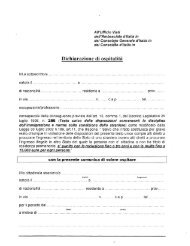Innovation Canada: A Call to Action
Innovation Canada: A Call to Action
Innovation Canada: A Call to Action
Create successful ePaper yourself
Turn your PDF publications into a flip-book with our unique Google optimized e-Paper software.
Vision and Principlesout in Chapter 5 — which would be a nationaldelivery agency for federal business innovationprogramming — should provide the technicalassessment of proposals for commercializationand R&D projects submitted <strong>to</strong> the regionaldevelopment agencies (RDAs), while servingas a platform for RDAs <strong>to</strong> share best practices.This would allow for increased cross-countrycollaboration and for the development ofcommon national standards of success inregional innovation.Establish Clear Outcome Objectives,Appropriate Scale and a User-OrientedApproachA program <strong>to</strong> foster business innovation shouldbe designed <strong>to</strong> address a specific problem forwhich a government initiative is needed as par<strong>to</strong>f the solution. The program should havewell-defined outcome objectives, be of a scaleappropriate for the problem at hand, be wellknown <strong>to</strong> its target clientele, and be easy andtimely <strong>to</strong> access and use. These fundamentaldesign principles, which should apply <strong>to</strong> allprograms, have led the Panel <strong>to</strong> recommend inChapter 5, for example, consolidation of groupsof subscale programs that have commonoutcome objectives.Design for FlexibilityFederal innovation programs should themselvesbe innovative and flexible in their design, settingclear objectives and measurable outcomes, andthen allowing program users <strong>to</strong> propose novelways of meeting the objectives. For example,where appropriate, programs should invite civilsociety <strong>to</strong> make proposals <strong>to</strong> develop newapproaches and <strong>to</strong> actually deliver programs,rather than relying exclusively on establishedgovernment delivery mechanisms. This designprinciple is in evidence in the Panel’srecommendations on programs in Chapter 5and on procurement in Chapter 7, where it isproposed that requests for proposals be based,wherever feasible, on a description of the needs<strong>to</strong> be met rather than on detailed technicalspecifications that leave <strong>to</strong>o little opportunityfor truly innovative solutions.Assess EffectivenessFinally, the Panel is convinced that moreextensive performance managementinformation is required <strong>to</strong> ensure an outcomedrivenand user-oriented approach <strong>to</strong> federalsupport for business innovation. This entailsregular public reporting on the outcomes bothof individual programs and of the full suite offederal innovation support. The performanceinformation would inform periodic evaluations,not only against the objectives of individualprograms, but also of the programs’ relativeeffectiveness within the overall portfolio.Comparative evaluation of this kind is anextremely challenging task, but it is key <strong>to</strong> anevidence-based reallocation of resources awayfrom underperforming programs and <strong>to</strong>wardnew or redesigned programs that can betterserve changing priorities and evolving businessneeds. To assist the government in this vitallyimportant regard, the Panel proposes improvedprogram evaluation approaches in Chapter 5and creation of an external <strong>Innovation</strong> AdvisoryCommittee in Chapter 8, which would inaddition provide whole-of-government adviceon the goals of innovation policy, onopportunities for new initiatives, and on anyother matters arising from the government’sinnovation agenda.4-3
















